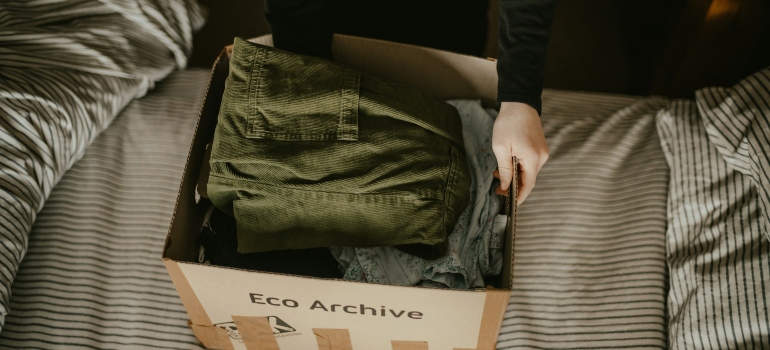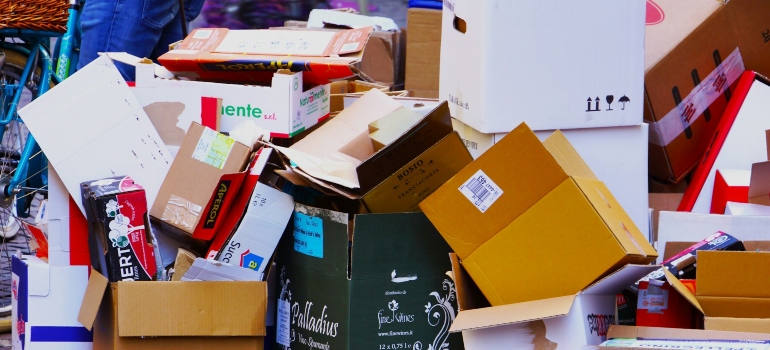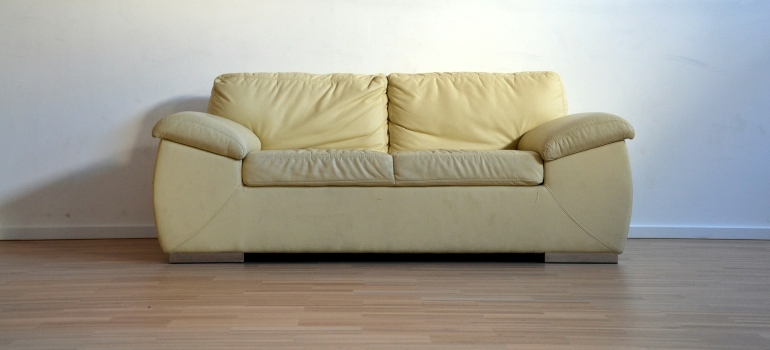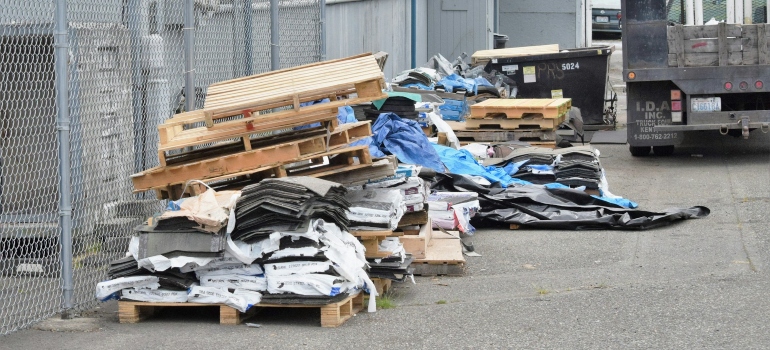Sustainable Unpacking and Disposal Post-Move
Moving to a new home in Seattle is an exciting milestone, but it often comes with an unintended consequence—waste. Piles of cardboard boxes, plastic wrapping, and unwanted items can quickly accumulate, leaving you wondering what to do with it all. Instead of sending everything to a landfill, sustainable unpacking and disposal can help you settle in while reducing your environmental impact. With a bit of planning, creativity, and our Hansen Bros Moving & Storage guide, you can repurpose materials, recycle responsibly, and dispose of items in a way that benefits both your home and the planet. Let’s explore how to make your post-move process as eco-friendly as possible.
A Smart Start: Unpacking with Sustainability in Mind
Tearing open boxes without a plan can create unnecessary waste and chaos. An intentional approach ensures that everything finds its place while keeping your disposal efforts mindful.
Organize Before You Unbox
Creating a structured unpacking plan makes it easier to track materials and reduces waste. Begin by designating areas in your home for different categories: recyclables, donations, and repurposed items. This prevents everything from becoming an overwhelming pile of clutter after your Washington movers leave your home.
Unpack one room at a time, beginning with essentials like kitchenware and toiletries. As you go, flatten and stack boxes neatly instead of discarding them immediately. Taking a measured approach ensures you don’t throw away useful materials in the rush to get settled. sustainable unpacking and disposal

Sort and Separate as You Go
Instead of waiting until the end of the unpacking process, separate waste immediately. Keep a recycling bin nearby for paper and plastics, a box for items to donate, and a pile for things that can be repurposed. This system saves time and keeps your space organized.
Engaging your household in the process makes it more efficient. If you have kids, turn sorting into a game—who can find the most reusable packing materials? Small efforts like these make a significant difference in reducing post-move waste.
Smart Solutions for Packing Materials: Reduce, Reuse, Recycle
The sheer volume of packing materials can feel overwhelming, but most of them can be repurposed, recycled, or donated. Knowing your options helps prevent unnecessary waste.
Giving Cardboard Boxes a Second Life
Cardboard is one of the easiest materials to reuse or recycle. Before tossing them in the blue bin, consider whether they can be useful for storage, DIY projects, or even future moves. Many local businesses and community groups welcome free boxes for their own shipping or moving needs.
If you have no use for them, flatten the moving boxes in Seattle and check the city’s curbside recycling guidelines to ensure they are disposed of properly. Removing tape and labels makes the recycling process more efficient.
Creative Ways to Handle Bubble Wrap and Packing Peanuts
Unlike cardboard, bubble wrap, and packing peanuts are trickier to recycle through standard curbside programs. Instead of throwing them away, store them for future use or donate them to local shipping stores that support sustainable unpacking and disposal of reusable packing materials.
For a creative touch, bubble wrap can be repurposed for insulating windows during colder months. Packing peanuts work well as lightweight fillers for potted plants, improving drainage without adding extra weight.
Managing Plastic Wrap and Packing Tape
Single-use plastics like shrink wrap and tape are less eco-friendly and harder to recycle. While you can’t always avoid them, reducing reliance on these materials for future moves is a great step. Opting for biodegradable packing materials next time can lessen your environmental footprint.
Some grocery stores and specialty recycling centers accept plastic film, so check local options before discarding it. Small changes in how you handle these materials make a lasting impact.

Get Creative: Turning Packing Waste into Something Useful
Instead of seeing unpacking waste as something to get rid of, look at it as an opportunity to repurpose and upcycle. Many packing materials have hidden potential for practical, everyday uses. Here are some smart ways to reuse moving supplies:
- Cardboard dividers: Cut up boxes to organize drawers, shelves, or closets.
- Bubble wrap insulation: Use it on windows to trap heat during Seattle’s chilly winters.
- Packing peanuts for plant drainage: Keep potted plants lightweight while improving soil aeration.
- Newspaper for composting: Shred old newsprint to add carbon to your compost pile.
- DIY pet beds or playhouses: Turn large boxes into creative spaces for kids or pets.
- Protective flooring: Lay cardboard down while assembling furniture or painting walls.
- Shipping material storage: Keep bubble wrap and air pillows for mailing future packages.
Packing materials can serve a second purpose before heading to the recycling bin. Small adjustments in how you handle these materials can reduce waste and add functionality to your new home. Also, simple repurposing efforts prevent waste and make the most of sustainable unpacking and disposal of materials that might otherwise end up in the trash.
Decluttering Responsibly: What to Do with Unwanted Items
Unpacking often reveals belongings that no longer fit your space or lifestyle. Instead of tossing them in the trash, consider ways to give them a second life. Thoughtful disposal not only reduces waste but also supports the community.
Donating Clothes and Textiles
Clothing, linens, and fabric-based items often get discarded after a move, but many organizations in Seattle accept gently used textiles. Thrift stores, shelters, and community centers welcome donations that can benefit those in need.
For items that are too worn for donation, textile recycling programs can repurpose them into insulation, industrial rags, or even new fabrics. Look for local initiatives like ThreadCycle, which partners with recycling facilities to keep textiles out of landfills, or for these donation options in Seattle:
- Goodwill & Salvation Army – Accepts gently used clothing and household textiles.
- Mary’s Place & Union Gospel Mission – Welcomes warm clothing donations for individuals experiencing homelessness.
- ThreadCycle Program – Recycles unusable textiles.
- Local Buy Nothing Groups – Great for giving away clothes directly to neighbors who need them.
Patagonia and The North Face also have take-back programs for worn-out apparel, ensuring they are recycled responsibly.
Rehoming Furniture and Household Goods
Bulky furniture or excess household goods can be a challenge post-move. Instead of leaving them on the curb, consider donating to local charities, listing them on neighborhood groups like Buy Nothing, or selling them through platforms like Facebook Marketplace, Craigslist, or OfferUp.
Organizations such as Habitat for Humanity’s ReStore or Seattle’s Furniture Bank accept furniture and household items in good condition, ensuring they go to families who need them. Many thrift stores also offer free pickup services, making it easier to donate large items without hassle.
For items that aren’t donation-worthy, consider upcycling projects before deciding to dispose of them. Refinishing an old table, repurposing wooden drawers into bookshelves, or turning fabric scraps into cushion covers are creative ways to reduce waste and personalize your new home.
Handling Electronics and Appliances the Right Way
Old electronics and appliances require special care if you plan sustainable unpacking and disposal. E-waste contains harmful materials like lead and mercury, which can damage the environment if not recycled properly. Many retailers, such as Best Buy, Staples, and Apple, offer take-back programs for electronics.
Seattle Public Utilities provides information on certified e-waste recycling facilities where you can drop off unwanted devices. Some electronics repair shops also accept old gadgets for parts or refurbishment. If your electronics are still functional, consider donating them to schools, libraries, or community centers that accept used technology.
Dealing with Hazardous Waste
Some household items, including paint, batteries, motor oil, fluorescent bulbs, and cleaning chemicals, fall under hazardous waste and cannot go into regular trash or recycling. Seattle has designated hazardous waste drop-off locations where you can safely dispose of these materials. Here’s how to handle hazardous waste in Seattle after relocation:
- King County’s Hazardous Waste Management Program – Offers drop-off locations and collection events.
- LightRecycle Washington – Accepts fluorescent tubes and CFL bulbs for safe disposal.
- AutoZone & O’Reilly Auto Parts – Take used motor oil and car batteries for recycling.
Keeping hazardous materials out of landfills helps protect Seattle’s environment and waterways, ensuring harmful chemicals don’t seep into the soil or water supply.

Creating a Sustainable Home from Day One
Once the unpacking and disposal process is complete, setting up sustainable habits in your new home ensures that eco-friendly practices continue beyond the move. A well-organized recycling system makes it easier to maintain sustainable habits. Set up clearly labeled bins for recyclables, compostables, and trash, and follow Seattle’s top recycling Do’s and Don’ts:
- Do recycle: Clean cardboard, paper, plastic containers, glass bottles, and metal cans.
- Don’t recycle: Greasy pizza boxes, Styrofoam, plastic bags, or food-contaminated items.
Seattle’s Seattle’s curbside recycling program accepts a wide range of materials, including paper, plastics, glass, and metals. However, contaminated or non-recyclable materials can disrupt the system.
Reduce Waste with Reusable Alternatives
Replacing single-use products with reusable alternatives minimizes long-term waste. Invest in:
- Glass or stainless steel food storage containers instead of disposable plastic.
- Beeswax wraps to replace plastic wrap.
- Silicone baking mats as an alternative to aluminum foil and parchment paper.
- Reusable grocery bags and produce bags to eliminate plastic waste.
- A water filtration system to avoid plastic water bottles.
Small shifts in your daily routine, after sustainable unpacking and disposal post move, significantly reduce your overall environmental footprint over time!
Support Local and Sustainable Brands
Making conscious purchasing decisions helps reduce waste and environmental impact. Choose eco-friendly packing materials, buy second-hand furniture, and support businesses committed to sustainability. Seattle’s local markets and thrift stores offer great options for sustainable shopping, including:
- Ballard Consignment & Pacific Galleries Antique Mall – Great for second-hand furniture.
- Scoop Marketplace – A zero-waste grocery store that offers bulk food and refillable household products.
- Eco Collective – Carries sustainable home goods, beauty, and cleaning products.
Buying locally also supports small businesses and reduces the carbon footprint associated with shipping goods long distances.
Embrace Minimalism for Future Moves
The less clutter you accumulate, the easier and less costly your moving services in Seattle will be. Adopting a minimalist approach prevents unnecessary accumulation and reduces the amount of packing materials needed next time you relocate. Here’s how to maintain a minimalist lifestyle.
Choose Quality Over Quantity
Investing in well-made, long-lasting products reduces the need for frequent replacements. Instead of buying multiple inexpensive items that wear out quickly, choose durable, sustainable alternatives. A high-quality, classic wardrobe, sturdy furniture, and reliable electronics minimize waste and add long-term value to your home.
Follow the “One In, One Out” Rule
Before bringing a new item into your home, consider removing something else. This simple habit prevents unnecessary accumulation and keeps your living space balanced. For example, if you buy a new kitchen appliance, donate or sell an old one. This mindset shift ensures that every new addition to your home is intentional.

Declutter Regularly Instead of Once a Year
Many people wait until spring cleaning or a move to purge unwanted items, but consistent decluttering keeps your home organized year-round. Set a routine—once a month, go through one area of your home and assess what you no longer use. Clothes, books, kitchen gadgets, and decor are great places to start. If something hasn’t been used in six months to a year, it’s probably time to let it go.
A Green Move Today for a Better Tomorrow
Sustainable unpacking and disposal aren’t just about managing waste; they’re about adopting a mindset that values conservation, creativity, and community. With a little effort, you can minimize the environmental impact of your move while making a positive contribution to Seattle’s sustainability efforts.
Choosing to donate, recycle, and repurpose materials benefits both you and the environment. The more intentional you are with your unpacking process, the less waste ends up in landfills. Your small actions today help build a cleaner, greener future for Seattle.
Ready to make a difference? Start by taking small steps—sort your waste mindfully, find new uses for packing materials, and support local recycling initiatives. The journey toward a sustainable home begins the moment you unpack.
Why Choose Us
History
Hansen Bros. Moving & Storage is locally owned and operated by the same family for four generations, since 1890. We have a well-established reputation for service quality and reliability with a high percentage of repeat household and commercial clients.
Professionalism
We’re a certified ProMover by the American Moving and Storage Association with A+ rating with the Better Business Bureau, voted “Best in Western Washington” in 2009 and from 2011 to 2016 by KING5. Our company is fully licensed and insured and member of WMC and AMSA.
Value
Hansen Bros. Moving & Storage provide free, no-obligation in-home estimate and competitive rates, including low minimum rates for shipments moving under 300 miles. We’ve set a refund policy for unused packing materials and three Puget Sound locations to help clients save on travel fee costs.



